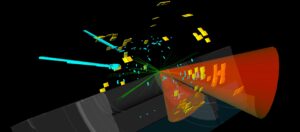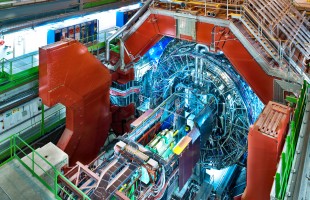The ATLAS detector at CERN has produced a new twice better estimate of the so-called self-coupling of the Higgs particle. This sensitivity to itself is the basis for how particles gain mass through the so-called Higgs mechanism.
At the Moriond spring conference, this year entirely online because of corona, physicists from ATLAS announced new measurements of the simultaneous creation of two Higgs particles during collisions of protons at the LHC accelerator. Such double processes are another factor of a thousand rarer than the creation of a single Higgs particle.

By collecting more measurements and using new analysis techniques, the new result is about twice as sharp as ATLAS’ previous estimate from 2018. There is no indication that the simplest form of the Higgs mechanism is incorrect, but the magnitude of a possible discrepancy has been greatly reduced.
In 2012, ATLAS and its sister experiment CMS at CERN first observed the origin of the Higgs particle by itself. Since then, pairs of higgs particles have also been seen, betrayed by the particles into which they subsequently disintegrate. Nikhef is not only a partner in ATLAS, but researchers from the institute are also involved in the new analyses.
Bottom quarks
For the new result, ATLAS is looking at the decay of Higgs pairs into two bottom quarks and two photons. From the measurements in this channel it can be deduced how often two higgs particles originate together at the same point.
This so-called self-coupling betrays in detail the way in which, according to the theory of Peter Higgs and others, particles can have mass. In the prevailing Standard Model of the particle world, elementary particles have no mass. That only happens at the hands of a universal Higgs field, which encompasses the entire universe. Particles are heavy when they feel a lot of that field, and lighter when it is less.
Exactly how that happens depends on the so-called higgs potential, an energy function roughly shaped like a Mexican hat with a high tip and a lower rim around it. The idea then is that at the big bang, the universe is at the tip, where particles do not have different masses. They don’t gain masses until the universe has moved from its shaky position in the central tip to a decentralized position in the rim.
Mexican hat
The mechanism devised in the 1970s by Peter Higgs and others assumes a simple parabolic shape for the hat. Self-coupling measurements allow us to verify whether the reality is really that simple.
Nikhef researcher Stefano Manzoni worked as a post-doc at CERN for three years on the higgs self-coupling. Sins 2020, he worked more on this new analysis with improved techniques. In the coming months, he says, he will focus with colleagues and students on combining this specific decay of a higgs pair with still other decays that are also being studied at ATLAS and also by Nikhef.
High-luminosity LHC
To get a really sharp picture of the Higgs self-coupling, we are waiting for further improvements to the LHC accelerator, which will eventually produce collisions ten times more intensively. In this high-luminosity LHC, which will come into operation after 2027, the extremely rare process can be visualized and studied ever more closely.

